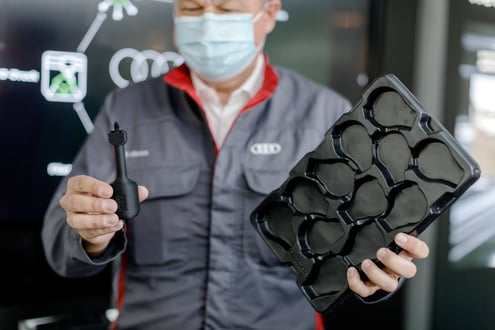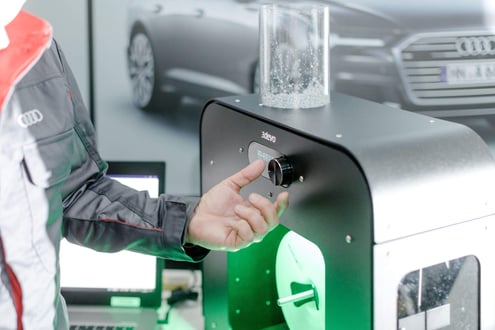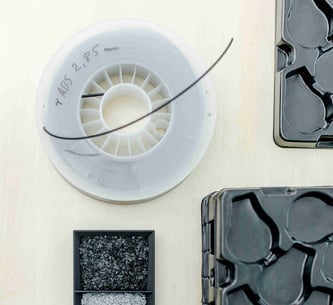Share this
Audi Produces Upcycled 3D Printed Components
by 3devo on Nov 4, 2021 10:12:00 AM

When a leading luxury car brand embraces recycling as its production strategy, it’s clear that sustainability has become the driving force even in resource-heavy industries like automotive.
Among the world’s most successful car manufacturers, Audi needs no introduction. For years, this German automotive company has been shaping the future of mobility with its innovative, bold yet reliable designs and production techniques. It’s only fitting that they now lead us into a new era of automotive design and manufacturing – where state-of-the-art components are made of recycled plastics.
In recent years, Audi has set its sights on minimizing waste and building sustainable products and processes that can reduce the environmental impact of its operations. In the automotive industry, where extensive use of plastics is the norm, this is quite an ambitious quest. Audi went about it by addressing the basic challenges faced at most of their sites.
Making “Mission:Zero” a Working Reality
To achieve net-zero carbon emissions at all sites in just a few years, Audi had to re-examine all aspects of research, design, production and transportation. A key area of concern was their overwhelming need for plastics to create the high-quality components used in their automobiles. As they couldn’t stop plastic use altogether or reduce it to a minimum without compromising on quality, they went ahead with a third option – closing the loop by turning waste plastics into usable raw material. This kick-started a series of experiments to explore the upcycling possibilities of the plastics they were using.
For the research team at Audi’s Neckarsulm site, the idea was simple but bold. “Our goal was to create a material cycle that would allow us to recycle some of the mixed plastics that accumulate during the production of, say, an Audi A7,” shares Volker Eitrich, project manager at the site. A few years ago, the team had already adopted 3D printing as a production technique for many of their automotive components. Now, supplementing the 3D printing setup with machines that facilitated plastic recycling was a natural next step.
To meet their goal, the Audi research team acquired a three-part setup consisting of the 3devo Shr3d It plastic shredder, Airid polymer dryer, and Composer 450 filament maker. Together, this arrangement would enable them to check whether they could shred unneeded plastics and convert them into 3D print-ready filament.
The team started by collecting packaging materials, sorting them by type, and then shredding them into granulate. The granulate was then fed into the polymer dryer to remove excess moisture that would otherwise compromise the quality of the extruded filament. As the last step, the granulate was extruded into usable filament via the Composer 450 filament maker.
"We’re focusing solidly on sustainability." -Volker Eitrich, Project ManagerThe success of the pilot project at Neckarsulm has cleared the way for a variety of upcycling ideas to unfold. The Audi research team is now equipped to process ABS, one of the most commonly used plastics in vehicle manufacturing, into usable parts and components. This is of course a significant step towards the German brand’s Mission: Zero initiative, but that’s not all. It is also a means to reduce operational costs and lead times
“The fact that the idea we worked on for so long is feasible and is helping protect the environment is incredibly motivating,” Eitrich shares. With a basic process established, the team will now look to scale things up further and produce enough filament to meet the needs of other sites as well.
We’re sure the months ahead will bring more exciting updates from Audi. We’re also sure this eco-conscious approach to design and manufacturing by a global automotive leader will trigger a transformation across the industry!
Share this
- November 2025 (1)
- October 2025 (1)
- March 2025 (1)
- January 2025 (1)
- December 2024 (2)
- November 2024 (2)
- October 2024 (4)
- September 2024 (2)
- August 2024 (3)
- July 2024 (6)
- June 2024 (3)
- May 2024 (2)
- April 2024 (1)
- March 2024 (1)
- January 2024 (1)
- November 2023 (2)
- October 2023 (5)
- September 2023 (2)
- August 2023 (1)
- July 2023 (1)
- May 2023 (1)
- December 2022 (2)
- June 2022 (1)
- May 2022 (2)
- April 2022 (2)
- March 2022 (6)
- February 2022 (2)
- January 2022 (3)
- December 2021 (3)
- November 2021 (3)
- October 2021 (2)
- September 2021 (3)
- August 2021 (3)
- July 2021 (2)
- June 2021 (1)
- March 2021 (1)
- October 2020 (1)
- June 2020 (1)
- May 2020 (1)
- April 2020 (4)
- November 2019 (1)
- July 2019 (2)
- June 2019 (1)
- May 2019 (1)
- March 2019 (1)
- November 2018 (1)
- September 2018 (1)
- January 2018 (1)
- October 2017 (1)
- September 2017 (1)
- July 2017 (1)
- June 2017 (1)
- May 2017 (1)
- January 2017 (1)
- December 2016 (3)
- November 2016 (2)
- October 2016 (1)
- May 2016 (2)
- August 2015 (2)
- July 2015 (1)


